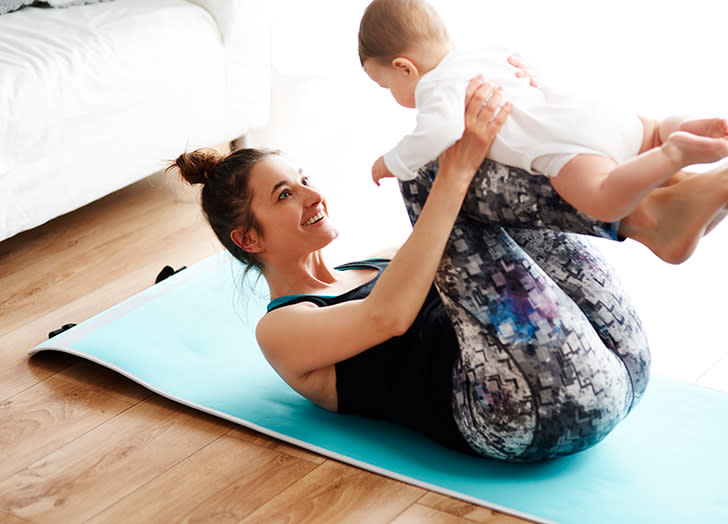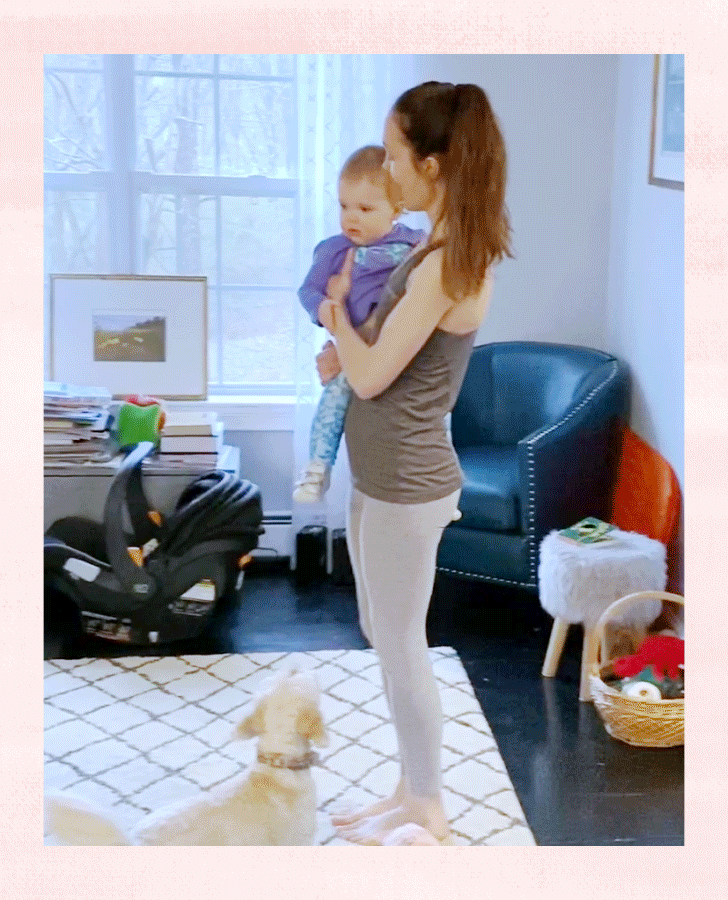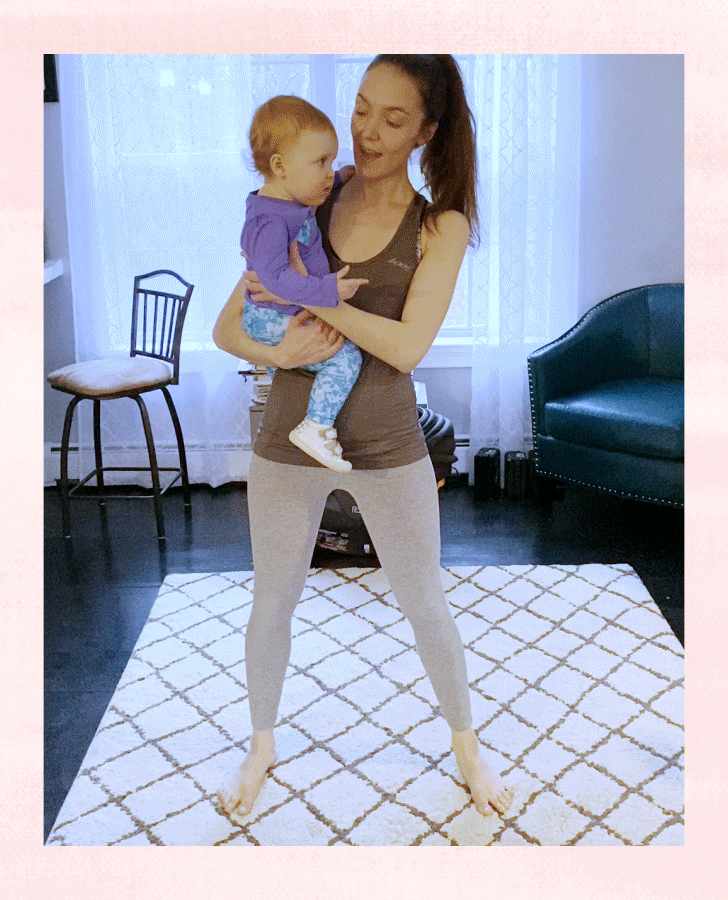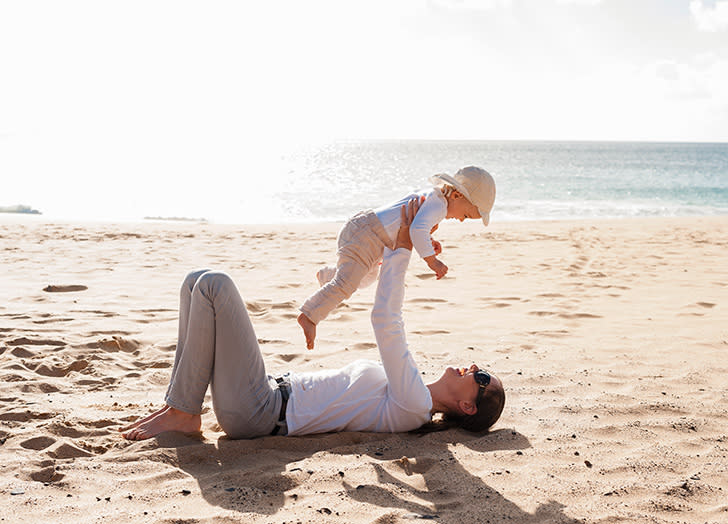The 7 Best Workouts You Can Do with a Baby

Postpartum exercise provides health benefits like strengthening and toning your abdominal muscles, boosting your energy, helping you sleep better and relieving stress. But due to weak muscles, an achy body and just plain exhaustion, you might not feel ready or maybe you’re even a little scared to start working out again. Plus, there’s always the time issue. Sure, you could squeeze in a sweat sesh while the baby naps, but you could also workout with baby on board with these seven mom-and-baby exercises.
RELATED: 44 Amazing Gifts for New Moms (That Are for Her, Not the Baby)

1. Baby Overhead Press
Sit cross-legged, holding your baby in front of your chest.
Make sure your elbows are bent and pressed against your rib cage.
Straighten your arms upward without locking your elbows.
Pause, then lower your baby to the starting position. Do ten reps, rest and then do two more sets.

2. Walking Lunges
Hold your baby in a comfortable position while standing tall and looking straight ahead.
Take a large step forward with your right leg and bend both knees 90 degrees.
Keep your front knee over your ankle as your back knee approaches the floor, heel lifted.
Push off the back leg and step your feet together. Shift your baby to the other side and repeat with the opposite leg.

3. Baby-Weight Squats
Stand with your head facing forward and your chest held up and out.
Place your feet shoulder-width apart or slightly wider, then push your hips back and down as if you’re sitting into an imaginary chair.
Make sure your thighs are parallel to the floor and your knees are over your ankles.
Press back up to stand. Do ten reps, rest, shift baby to other side, and then do two more sets.

4. PeekaBoo Push-ups
Lay your baby on a cushioned surface and get into a push-up position (on your knees is totally fine).
Keeping your elbows close to your body, lower yourself down so that you come face-to-face with your baby.
Bracing your core, push yourself back up to the starting position.
Do ten reps, rest and then do two more sets. You can also turn this one into a plank by holding the top part of the push-up position.
(Note: If your little one—like our adorable model—doesn’t want to sit still, set up some safe distractions nearby for play.)

5. Baby Bench Press
Lie face up on the floor with your knees bent. Contract your abs.
Hold your baby securely on top of your chest.
Press your arms straight up, pause and then lower your baby to the starting position.
Do ten reps, rest and then do two more sets.

6. Strolls with...a Stroller
It seems kind of obvious, but just pushing your baby’s stroller around the block is great exercise—and an excuse to get out of the house. Once you get the go-ahead from your doctor for more strenuous activities, you can also turn this into a light jog.
7. Baby Yoga
OK, so this one is a little bit more for baby than for mom, but it’s so darn cute we had to include it. Namaste, bebe.

4 Things to Know About Postnatal Exercise
1. When Can You Start Exercising After Giving Birth?
Since every woman’s postpartum recovery is different, Huma Farid, M.D., of Boston’s Beth Israel Deaconess Medical Center, says that the time to start exercising after giving birth depends on “how much the woman exercised during pregnancy, what kind of delivery she had and whether there were any complications during delivery.”
Also, your fitness level pre-pregnancy can be a determining factor. If you were exercising regularly and in good physical condition before you got pregnant, you’ll probably have an easier time getting back into it after giving birth. But “don’t try to do all you did before or begin a strenuous new routine for at least a couple of months,” says Felice Gersh, M.D., founder and director of the Integrative Medical Group of Irvine and author of PCOS SOS: A Gynecologist’s Lifeline to Naturally Restore Your Rhythms, Hormones and Happiness.
“In general, for women who had an uncomplicated vaginal delivery, they can start exercising gradually as soon as they feel ready,” Dr. Farid says. “Most women are able to resume exercising about four to six weeks after an uncomplicated delivery.” Be sure to check with your doctor about starting an exercise routine (usually during your standard six-week postpartum checkup), especially if you had a cesarean birth or other complications. “For women who have had a C-section, that [start time] may be extended to six weeks after delivery. Women can return to the gym safely by six weeks postpartum, but their joints and ligaments may not return to their pre-pregnancy state until three months postpartum.”
That’s because of relaxin, the hormone that loosens your joints in preparation for labor. It can remain in your body well after birth, which means you might be wobblier and experience more aches and pains. So keep that in mind as you begin your postpartum workouts. Dr. Farid suggests starting with a brisk walk around the block to get an idea of how your body has healed. Overall, you’ll want to start gradually and gently. No new mom will be ready to run a marathon right away, but you may feel like you just ran one.
“I advise my patients to listen to their bodies and exercise as much or as little as they feel is reasonable,” Dr. Farid says. “If exercising is causing pain, I recommend that they wait one to two more weeks prior to starting again. They should increase the amount of exercise gradually, and for women who have had a C-section, I recommend avoiding heavy lifting (such as weight training) for six weeks. I would recommend starting gradually with brisk walks about ten to 15 minutes in duration and increasing gradually.”
Dr. Gersh also recommends taking a well-paced walk after each meal and starting with “light weights at six weeks postpartum for vaginal deliveries and eight weeks after a C-section.” You might also want to work up to body-weight exercises like push-ups, pull-ups and squats.
Other low-impact aerobic activities to consider include swimming, water aerobics and gentle yoga or simply stretching. At the gym, hop on the stationary bike, elliptical or stair climber.
2. How Much Should You Exercise After Giving Birth?
According to the U.S. Office of Disease Prevention and Health Promotion’s physical activity guidelines, adults should get at least 150 minutes of exercise per week (about 30 minutes a day, five days a week, or three ten-minute walks each day). “But realistically, many women with new babies struggle to carve out the time to exercise,” Dr. Farid says. “If a woman cannot find time to exercise and has just given birth, I would encourage her to give herself a break and exercise when she can. Taking walks with the baby in the stroller or the carrier is a great form of exercise. And when she has time, she can resume more vigorous physical activity at the gym.” Some gyms even offer babysitting services, or you can look into mommy-and-me fitness classes like a baby boot camp program once your little one is old enough. Also, keep in mind that some classes like indoor cycling may include movements that are too intense for postpartum moms, so notify the instructor that you’ve recently given birth and they can offer adjustments as needed.
3. Are Kegels Really Necessary?
Besides stretched-out ab muscles, your pelvic floor will also be weak. To help strengthen the bladder muscles that can be damaged during pregnancy and childbirth, Dr. Farid recommends practicing Kegel exercises. In addition to walking, Kegels should be one of the first exercises you incorporate into your postpartum routine. To do them, pretend you’re trying to stop the flow of pee by tightening your pelvic floor muscles from front to back. Hold and release. Do this about 20 times for ten seconds each time, five times a day. This will help with bladder and bowel control as well as prepping your vagina for postpartum sex.
4. What About Core Work?
During pregnancy, as your belly expands, the tummy’s connective tissue is stretched out and the rectus abdominis (the muscles that run vertically down the sides of your abdomen) can get pulled apart and separate down the middle. This is known as diastasis recti, and most pregnant women experience it. For some women, the gap closes up quickly, while others may have separation up to six months postpartum. If your belly still looks pregnant months after you’ve delivered your baby, you probably have diastasis recti. And this is why getting that six-pack back (or for the first time) will be challenging.
Instead of doing a million crunches, which can actually make the condition worse by pushing the muscles farther apart, try doing planks and focus on strengthening your deepest abdominal muscles (known as the transverse abdominis or TVA muscle) to regain your core strength and stability. But ask your doctor before attempting any ab exercises since you may need to see a physical therapist who specializes in postpartum training, depending how severe the diastasis recti is.
RELATED: What Happens to Your Brain When You Have a Baby, According to a Psychologist

